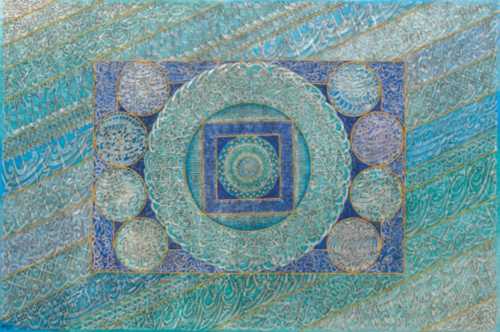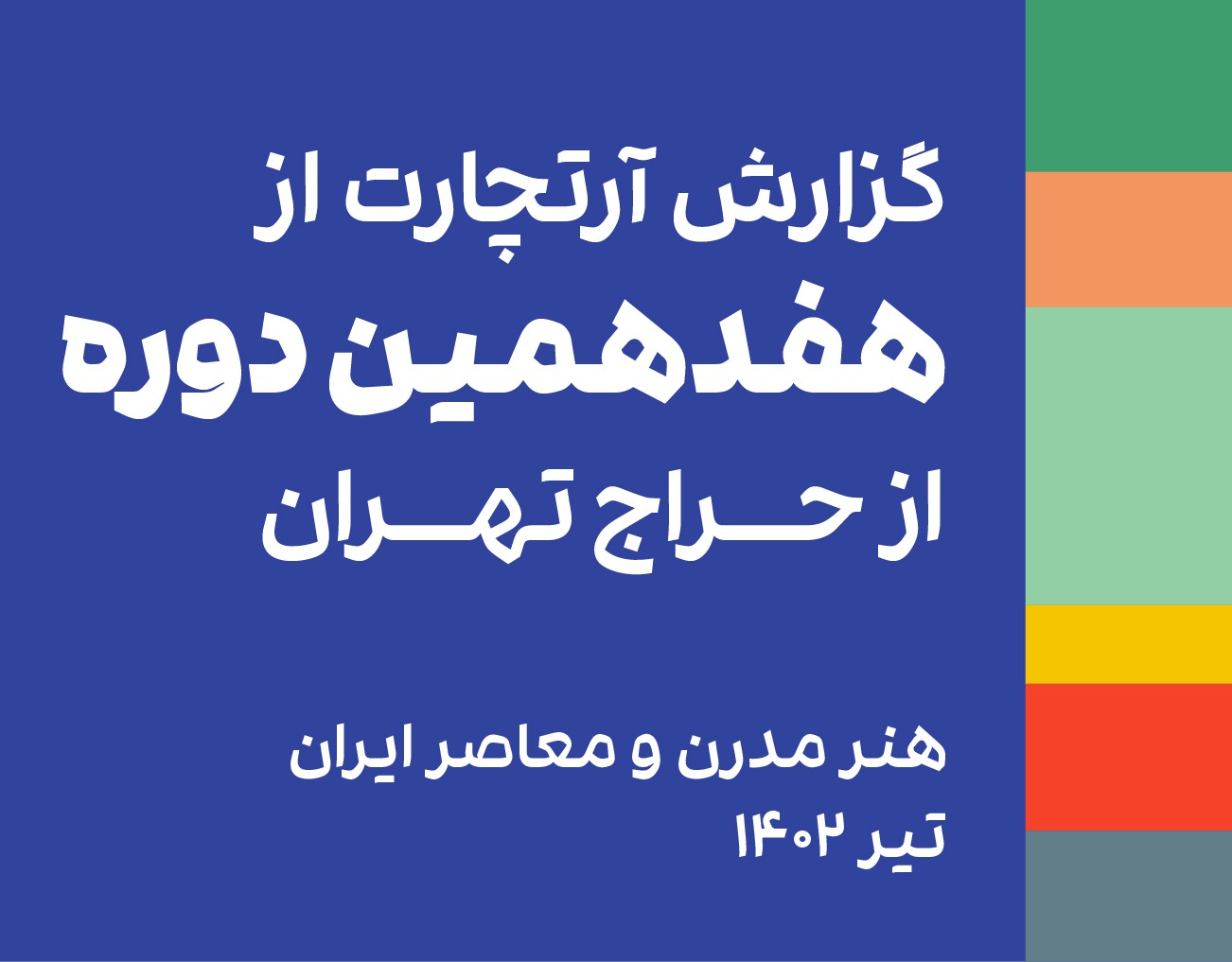About Mahmoud Zenderoudi
Mahmoud Zenderoudi, known as "Zende", is an Iranian modernist painter. He is often associated with the Sagha Khaneh movement and his calligraphic painting artworks. Zenderoudi was born in 1943 in Karaj and became interested in art influenced by his mother.
He was 19 when he participated in the second Tehran biennial with his calligraphic painting artworks. His first solo exhibition was held at the Tehran Gallery in 1966, and four years later he participated in the Tehran International Exhibition. Zanderoudi left Iran for southern France at the same time as the Revolution of 1979, where he settled and devoted his life to painting. In his works, he uses the traditional methods of Sagha Khaneh, such as stamping, stereotyping, engraving and calligraphy, but some of his techniques are unique and different from other artists. Most of Zenderoudi's technical achievements formed during his artistic career abroad. Especially after 1988, Zenderoudi gained new experiences in working with materials, techniques and expression. In some of his works, he used collage techniques with putting together junk and disposable materials such as Shredded newspapers, cardboard cutting clippings, banner and poster clippings, scrapbooks, soda bottle trays, and even dried potatoes . After 1992, he used a kind of handmade paper, which later became the main feature of several periods of his career. "Zende's Paper" was the name given to this paper by the famous art expert Jean-Pierre Roux. Zenderoudi signs his works with his nickname "Zende" and is known by the same name in Western art circles. Zenderoudi has also gone for volume and layout in his extensive searches. The spheres and columns, which are covered with a motif of letters and words are his most familiar experiences in the volumetric art. During these experiences, Zendeh also decorated pages from antique books or the bodies of objects such as pianos, computer keyboards, and electronic circuits.
Claude Bertoli, a painter and sculptor, writes about the place of materials in the artist's works: "To express his Iranian nature, he first seeks the kindness of the raw materials he consumes. soft papers like brocade fabrics and wavy cartons. He spreads them in a strange labyrinth like intertwined beehive nets. Then there are the magical letters that have made Persian calligraphy infinitely rich for centuries. Letters and words sink into each other's arms and intertwine together and become form and beauty before expressing poetry, words or literature."
Anthony Blanche ,the journalist, writes of Zandroudi's experiences in writing and decorating pages: "using peels and manuscripts is an emphasis of the book's dignity not its words. The artist revives what we want to sustain. He always deceives us about the nature and kind of the materials and tools he used, and this is a testament to his technical skills and expertise."
He was 19 when he participated in the second Tehran biennial with his calligraphic painting artworks. His first solo exhibition was held at the Tehran Gallery in 1966, and four years later he participated in the Tehran International Exhibition. Zanderoudi left Iran for southern France at the same time as the Revolution of 1979, where he settled and devoted his life to painting. In his works, he uses the traditional methods of Sagha Khaneh, such as stamping, stereotyping, engraving and calligraphy, but some of his techniques are unique and different from other artists. Most of Zenderoudi's technical achievements formed during his artistic career abroad. Especially after 1988, Zenderoudi gained new experiences in working with materials, techniques and expression. In some of his works, he used collage techniques with putting together junk and disposable materials such as Shredded newspapers, cardboard cutting clippings, banner and poster clippings, scrapbooks, soda bottle trays, and even dried potatoes . After 1992, he used a kind of handmade paper, which later became the main feature of several periods of his career. "Zende's Paper" was the name given to this paper by the famous art expert Jean-Pierre Roux. Zenderoudi signs his works with his nickname "Zende" and is known by the same name in Western art circles. Zenderoudi has also gone for volume and layout in his extensive searches. The spheres and columns, which are covered with a motif of letters and words are his most familiar experiences in the volumetric art. During these experiences, Zendeh also decorated pages from antique books or the bodies of objects such as pianos, computer keyboards, and electronic circuits.
Claude Bertoli, a painter and sculptor, writes about the place of materials in the artist's works: "To express his Iranian nature, he first seeks the kindness of the raw materials he consumes. soft papers like brocade fabrics and wavy cartons. He spreads them in a strange labyrinth like intertwined beehive nets. Then there are the magical letters that have made Persian calligraphy infinitely rich for centuries. Letters and words sink into each other's arms and intertwine together and become form and beauty before expressing poetry, words or literature."
Anthony Blanche ,the journalist, writes of Zandroudi's experiences in writing and decorating pages: "using peels and manuscripts is an emphasis of the book's dignity not its words. The artist revives what we want to sustain. He always deceives us about the nature and kind of the materials and tools he used, and this is a testament to his technical skills and expertise."
The Most Expensive Artwork
At Auctions
First Attendance
29 May 2015
# Attendance
20
# Artworks
28
Average Realized Price
28,718 USD
Average Min Estimate
19,095 USD
Average Max Estimate
26,107 USD
Sell-through Rate
59.259%
Average Growth of Artwork Worth
44.821%
Timeline
General Sale auction
8 December
Middle East / 20th Century Art / n°21 auction
6 July
The 23rd Tehran - Modern and Contemporary Iranian Art auction
22 May
The 22nd Tehran - Modern, Classic and Traditional Iranian Art auction
14 February
Resize exhibition
16 August
The 20th Tehran- Modern and Contemporary Iranian Art auction
5 July
Zende exhibition
19 April
The Range of Meaning exhibition
1 March
The 19th Tehran -Classic and Modern Iranian Art auction
24 January
Vente ONLINE ONLY auction
18 September
The 17th Tehran Modern and Contemporary Iranian Art auction
18 July
21st Century Art - Art Nouveau - Art Deco - Design - Modern and Contemporary Art auction
26 November
Selected 6 exhibition
16 September
Lotfi x Mashahir Cross 2 exhibition
9 September
Tehran- 16th- Iranian contemporary art auction
1 July
Oriental Art - Islamic Art auction
17 May
TABLEAUX MODERNES & CONTEMPORAINS - SCULPTURES auction
27 April
The last event 1400 exhibition
25 February
The 15th Tehran- Modern Iranian Art auction
14 January
The 14th Tehran- Contemporary Iranian Art auction
12 August
The 13th Tehran- Modern and Contemporary Iranian Art auction
15 January
Collector 6 exhibition
18 September
5th Collector exhibition
24 January
دوازدهمین دوره حراج تهران auction
17 January
دهمین دوره حراج تهران auction
11 January
4th National auction
27 July
هشتمین دوره حراج تهران auction
12 January
چهارمین دوره حراج تهران auction
29 May
Live exhibition
23 May
Articles
۱7th Tehran Auction Sales Report 26 July 2023
The 17th Tehran auction: modern and contemporary, was held on Friday July 21st, 2023 at Parsian Azadi Hotel. This auction achieved a total sale of 214 billion tomans equivalent to 4.3 million dollars, which was a growth of 77.8% compared to the previous period. Artchart has observed the 17th Tehran auction in the upcoming report.

